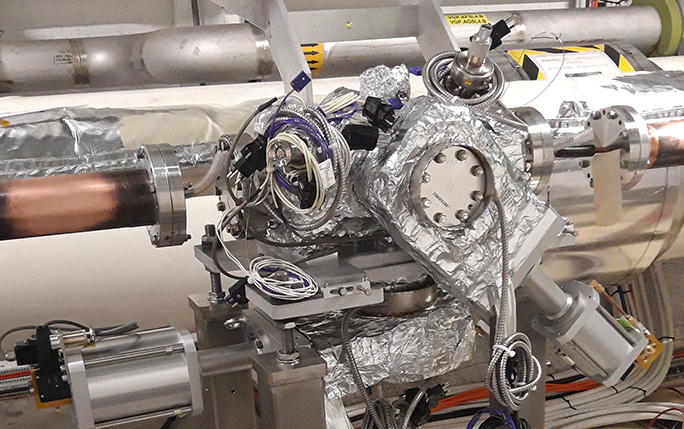New monitor type installed in the Large Hadron Collider

A beam gas curtain monitor that has been developed between experts from the Cockcroft Institute/University of Liverpool, CERN and GSI within the STFC-funded HLLHC-UK project has been successfully installed in the world’s largest and highest energy particle accelerator, the Large Hadron Colllider (LHC). This discovery machine is due an important update over the next few years, increasing its luminosity. Luminosity is an important parameter that describes how many collisions can take place in a particle collider over a given period of time. It is hence a measure of the discovery potential of the LHC.
The aim of the beam gas curtain monitor is to characterise the high energy proton beam, as well as the beam in the hollow electron lens - a device to remove halo particles from the proton beam - in a least-invasive way. A supersonic gas jet, shaped into a thin curtain, forms the core of this new monitor. The development was urgently needed as no currently used technology would be suitable to measure the properties of the HLLHC beams.
An important milestone was reached this month by installing the monitor’s interaction chamber, where the proton and electron beams interact with the gas jet, within the main beam line of the LHC. Such an installation is only possible during an LHC shutdown period as the accelerator cannot operate during installation.
The vacuum chamber was precision-machined, its interior blackened, and its vacuum characteristics carefully tested before the installation. Despite significant challenges caused by the COVID-19 pandemic, including the closure of CERN and Daresbury campuses for several weeks, the project has made excellent progress and the installation was completed on schedule.
Professor Carsten Welsch, who leads the UK project, said: “This installation marks an important milestone for the project and all members of the collaboration are to be congratulated for this success and thanked for their fantastic work. It also marks the start of a new phase in the project where we will aim at measuring the profile of the 7 TeV proton beam after the LHC restart next year.”
The planned initial measurements will use a local pressure bump created by a needle valve. This will give important insight into cross sections at new energy levels, as well as achievable signal levels. In parallel, researchers from the Cockcroft Institute/University of Liverpool will continue experimental studies at two purpose-build test stands in the UK into monitor optimisation. Once fully commissioned, these monitors will also be installed in the LHC. This will pave the way for non-invasive beam characterisation of the LHC beams. Exciting times lie ahead!
You will find more information about the monitor in the following articles:
'A supersonic gas jet-based beam profile monitor using fluorescence for HL-LHC', H.D. Zhang, et al. Proc. IPAC18, Vancouver, Canada. (2018) WEPAF034
'Design and first operation of a supersonic gas jet based beam profile monitor', V. Tzoganis, et al., Phys. Rev. AB 20, 062801 (2017) https://doi.org/10.1103/PhysRevAccelBeams.20.062801
'A non-invasive beam profile monitor for charged particle beams', V. Tzoganis, C. P. Welsch, Applied Physics Letters 104, 204104 (2014) (1.4879285)